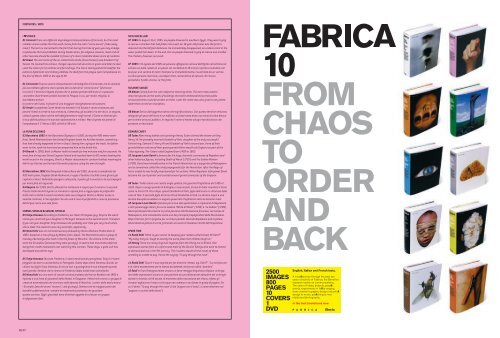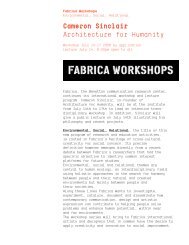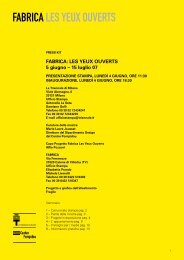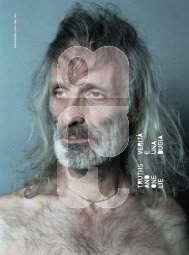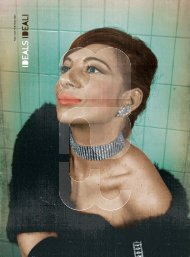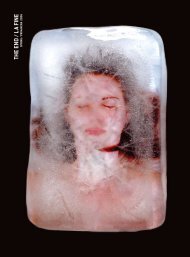Create successful ePaper yourself
Turn your PDF publications into a flip-book with our unique Google optimized e-Paper software.
A SOUVENIR FROM VENICE<br />
It’s not the usual postcard or even a cliché Carnival1 mask, colored<br />
Murano glass, super kitsch miniature gondola or straw hat with<br />
“I Venice” written on it.<br />
It is an editorial project that invites young writers and<br />
videomakers to discover a different and amazing new city, and<br />
to say that Venice, the real one, made of bricks and water, isn’t<br />
sinking at all. In fact, a side of the city that you didn’t even know<br />
existed is emerging.<br />
VENICE NOW AND FOREVER<br />
Romantic, fun, mysterious, wintry, summery, packed with<br />
tourists, full of student spirit, ready for Carnival, cinematic, etc.<br />
Is it even possible to find another perspective on Venice? To<br />
see the city as it is once and for all and not as the destination of<br />
thousands of tourists? The project, conducted by Fabrica and the<br />
cultural association “Venice is not sinking” (founded with Studio<br />
Camuffo), is attempting to do just that. The idea is an unusual<br />
one: describing Venice through its administrative districts,<br />
searching for the hidden identities of a city that has a thousand<br />
and one faces.<br />
DAVIDE BALLIANO. ITALIAN. PHOTOGRAPHER. CANNAREGIO.<br />
What do you like most about Venice? At first glance Venice<br />
seems like a huge tent built for tourists. It looks a bit like an<br />
Italian Las Vegas – all gondolas and canals. The side of Venice<br />
that I love most is light years away from this. To find it you must<br />
go looking for it and get away from those damned tourist routes<br />
where everyone is lined up.<br />
What characteristic of Venice has made the biggest impression<br />
on you? For me the power of Venice is in the details. It is a city<br />
packed with tiny details that define the style and flavor of an<br />
area. And another thing, as far as I have been able to make out,<br />
Venice is a city in which the color green2 dominates. Everything<br />
seems green to me: the door handles, the clotheslines, the water,<br />
the shutters on houses and the trees, doors, boats...Venice is<br />
definitely green.<br />
What did you discover while exploring the Cannaregio district?<br />
It’s hard to be impressed by Venice again and find new aspects,<br />
perspectives and outlooks. But walking around Cannaregio I was<br />
surprised when I saw the island that holds the cemetery. There’s<br />
something about that vision that is both magnificent and dark.<br />
<br />
<br />
<br />
<br />
<br />
<br />
<br />
<br />
<br />
<br />
<br />
<br />
<br />
<br />
<br />
<br />
<br />
<br />
<br />
<br />
<br />
<br />
<br />
<br />
<br />
<br />
<br />
<br />
<br />
<br />
<br />
<br />
<br />
<br />
<br />
<br />
<br />
<br />
<br />
CONRADO ALMADA. BRAZILIAN. VIDEOMAKER. SAN MARCO.<br />
What did you think you would find in Venice? In Brazil people<br />
think that Venice is a smelly city. Now that I am here I can<br />
officially prove them wrong. As for the rest, the image we have<br />
of Venice in Brazil isn’t too far from the reality: gondolas, canals,<br />
bridges and a thousand “romantic” moments! It’s the ideal city<br />
to bring a girl.<br />
Why did you choose the San Marco district, where most of the<br />
tourists are? I’ve always been scared of tourists. So this time,<br />
instead of trying to avoid them by slipping into narrow alleys,<br />
I decided to come face to face with them.<br />
How did you do that? I made a video about them, about the<br />
tourists. I tried to look at them from an ironic perspective,<br />
highlighting their rituals, their clichés and the repetitiveness<br />
with which they move around the city, always taking the same<br />
photos and stopping to eat at the same places.<br />
ANDY LUKE. ROMANIAN. WRITER. DORSODURO.<br />
What did you think Venice would be like? I though that in Venice<br />
you could only get around by boat or vaporetto, I didn’t think that<br />
you could walk as well. The first time I went to Venice I wanted to<br />
be cool so I didn’t buy a map of the city because it was something<br />
I saw only tourists doing. I got lost and I walked around in circles<br />
for a long time.<br />
What do you think is the best thing about Venice? I think that<br />
the best part of the city is hiding in the small alleys and the<br />
deserted lanes. As I was wandering around I came across little<br />
works of art on the walls of the city more than once. I’m not just<br />
talking about old art or architecture, but also of extraordinary<br />
examples of street art.<br />
And what is the worst aspect? The ten thousand souvenir shops<br />
that clog up the city. I don’t like plastic gondolas and I hate all the<br />
objects without history made for tourists. The souvenirs in Venice<br />
are really horrible, kitsch and also way too expensive.<br />
What struck you about the Dorsoduro district? The smell of<br />
wood that you can inhale in every corner. And then the port and<br />
the abandoned areas... that is the Venice that I like.<br />
“Venice is not sinking” isn’t just the name of an association<br />
that aims to promote cultural projects in Venice. It is first and<br />
foremost a battle cry, a communication of intent and a symbolic<br />
answer to all those who think Venice is a dead city submerged in<br />
water and a tide of tourists.<br />
The organizers and founders have decided to put this statement<br />
in black and white and it sounds a bit like “now we’ll show<br />
you!” The project consists of a book and DVD pack. The book<br />
is a collection of stories by six young Venetian writers and six<br />
foreigners (or rather non-Venetians). Each has taken a different<br />
district and analyzed it by walking all over and studying it day<br />
and night for three full days. Then each one, using their own<br />
particular style, has described what they saw in the form of<br />
a literary reportage<br />
In the DVD enclosed with the book, the challenge is handed to<br />
young filmmakers and photographers. The result is an editorial<br />
product that is completely different from the usual mix of dreamy<br />
gondolas and sea gulls. They’ve walked all over the city looking<br />
with an eye that is creative, unusual, irreverent, inquiring and<br />
free from those conventional molds that are now obsolete and<br />
have made Venice the icon of romanticism and tradition.<br />
36/37


